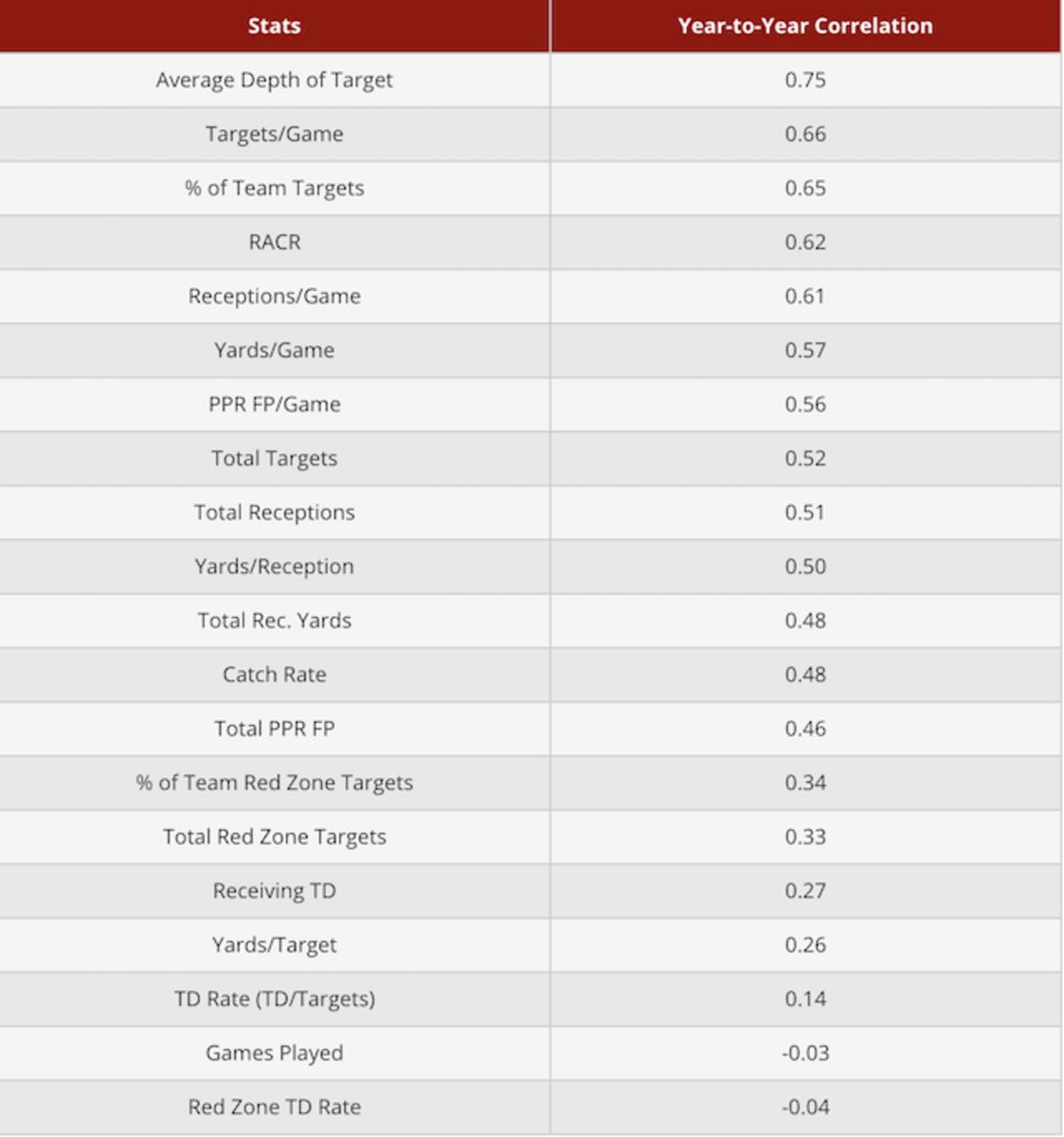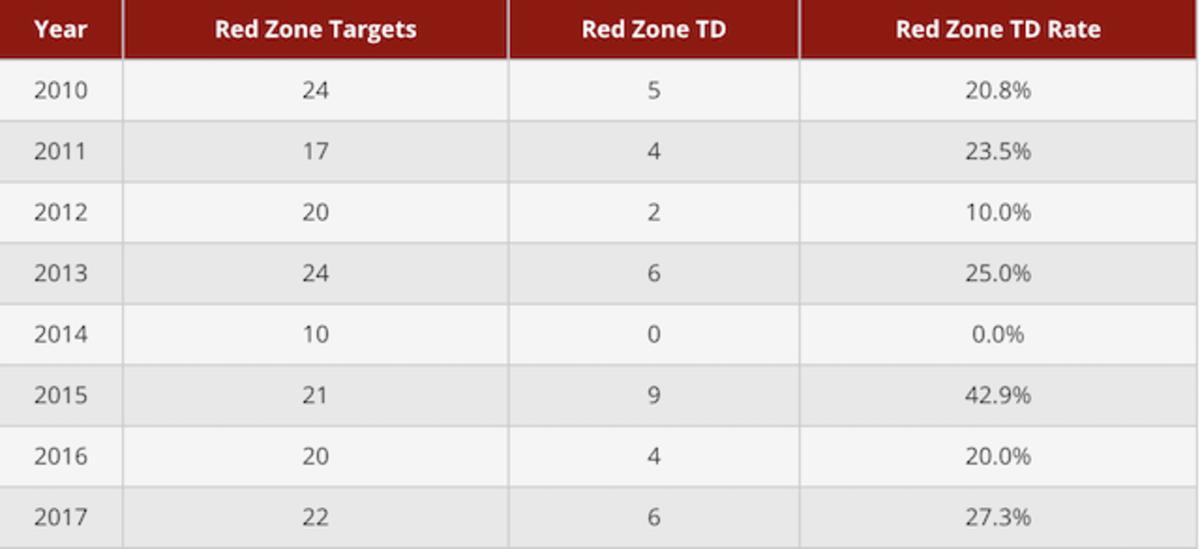The Most Predictable Wide Receiver Stats

The goal of this study is to uncover which frequently referenced previous-year stats for wide receivers are reliable indicators of future performance, and which of those stats may be misleading.
Methodology
In hopes of keeping this study controlled, the study considered receivers from 2010 through last year who saw at least 65 targets and remained on the same team in consecutive seasons. So many variables change from one year to the next in the NFL, and since a study like this can be inherently sensitive to outliers, eliminating something as drastic as a team change should remove some noise. Sixty-five targets is an arbitrary cutoff, but should be sufficient enough of a sample to gauge a player's performance level in a season, even if it was cut short unexpectedly.

This methodology offers us a sample of 244 instances in which a wide receiver met the volume threshold in consecutive seasons for the same team.
The following table gives the correlations for 20 statistics that are commonly cited when trying to project a wide receiver's upcoming season:
Year-to-Year Statistical Correlations for WRs on Same Team in Consecutive Seasons (since 2010, min. 65 targets)

Per-game stats have the strongest year-to-year correlations for wide receivers. When you consider that these stats simply represent a player's average performance, this should come as no surprise.
On the other hand, volume stats will fluctuate if a player misses a handful of games, and the number games a player plays has virtually no correlation from one year to the next.
When Projecting Receivers, Target Targets
Receiver production, in both real football and fantasy, hinges on targets. Those targets are the number that we can most confidently look to from a receiver’s previous season when trying to project his upcoming year. Although per-game receptions, yards and fantasy points have moderate year-to-year correlations, targets have a year-to-year correlation that is on the brink of being considered statistically strong.
The Most Predictable Quarterback Stats
PPR scoring somewhat mitigates the effect of touchdowns on the bottom-line fantasy scoring, so it makes sense that a receiver can have somewhat consistent year-to-year fantasy output despite a moderately weak correlation in touchdowns from one year to the next.
Even with the correlation in per-game production overall from year to year being moderately strong, it isn’t so strong that we can look at the previous season and think that a wide receiver will easily replicate his numbers.
All Efficiency is not Created Equal
No efficiency metric for wide receivers is notably reliable from one year to the next, but yards per target and touchdown rate can have especially large yearly fluctuations.
Since catch rate, targets, receptions, and yards all only have moderate year-to-year correlations, it makes sense that there can be a disconnect between yards per reception and yards per target correlations from one year to the next. All of these stats may vary on a yearly basis, but that doesn’t mean they all move in the same direction. In other words, if a receiver has a catch rate of 60% one year and 50% the next, but maintains his yardage and reception totals, his yards per reception won't change, but his yards per target will see a significant drop-off.
Touchdowns are such a rare occurrence relative to targets that even a swing in just a couple of scores per season can have a huge impact on touchdown rate, hence the weak year-to-year correlation.
Be Wary of the Red Zone
It’s important to pinpoint receivers who have a good chance at scoring, and the moderate correlations that we see in red-zone targets and red-zone target share suggest that we can make educated guesses based on previous data as to which receivers will have opportunities near the goal line. Assuming that those opportunities will absolutely turn into scores, though, is a fool’s game.
It’s a matter of sample size. Even the most heavily targeted red-zone threats will only see about 25 red-zone looks in a season. This is nowhere near enough targets for a player to score as often as we would expect them to in the red zone.
Fantasy Football 2018: Wide Receiver Primer
Consider Larry Fitzgerald, who has seen the most red-zone targets among wide receivers since 2010, and whose touchdown rate during that span (22%) is very close to the league average over the same time period (23%):
Larry Fitzgerald Year-to-Year Red Zone TD Rate

Fitzgerald’s year-to-year touchdown rate highlights how scoring rates can fluctuate, even for the league’s most consistent red-zone targets. Although certain players seem to dominate the red zone year in and year out, the best way to approach scoring rates is to consider a player’s performance in one year and compare those numbers to the league average, or to his individual average if the sample is large enough. You can then decide to what extent regression to the mean should be expected.
Using Air Yards for Fantasy Success
Earlier this offseason, Josh Hermsmeyer explained the importance of air yards as it pertains to predicting fantasy football success—specifically looking at average depth of target (aDOT) and Receiver Air Conversion Ratio (RACR). In short, we want to find out how efficient a player is at their most common depth of target. RACR captures this, and when combined with aDOT can measure a player's receiving yards with great confidence. The year-over-year stickiness of aDOT and RACR for wide receivers compared with tight ends makes this especially important to consider for former. As two of the most consistent wide receiver metrics, Hermsmeyer’s method of projecting production through air yards is a viable one for anyone who wants to run their own projections against the public.
Fantasy Football 2018: Tight End Primer
Bottom Line
When reflecting on a wide receiver’s stats from one season and trying to project his numbers for the following year, there are a few key points to bear in mind:
Targets are the most predictable year-to-year stats for wide receivers. Receptions, yards and fantasy points are simply the results of those targets.
Not all efficiency metrics are reliable. Variance in catch rate can drive a gap between yards per reception and yards per target. Touchdown rate cannot be derived from last season’s performance.
Red-zone usage is an indicator of opportunity, but not a guarantee for touchdowns.
Air yards and target depth have proven to be among the most stable year-to-year metrics and can help predict yardage output for wide receivers.
